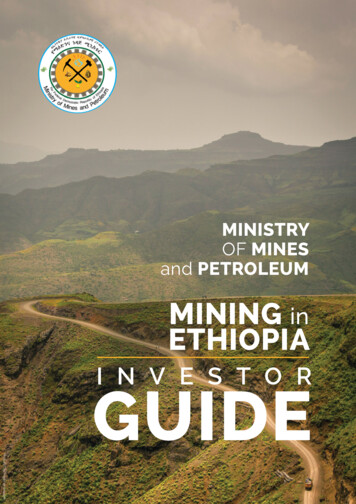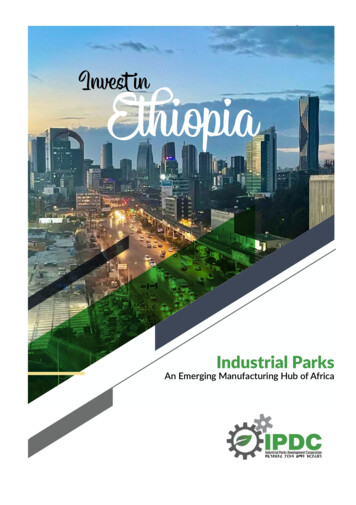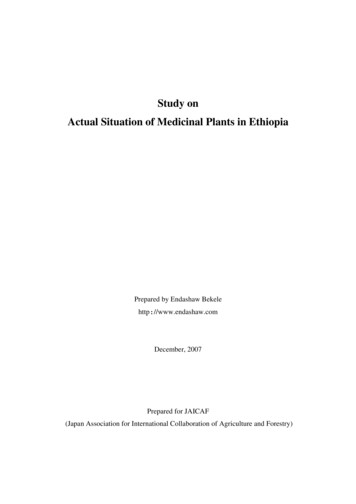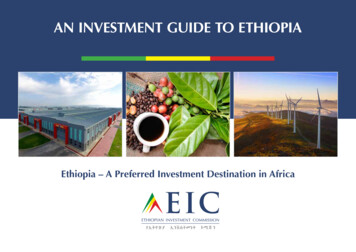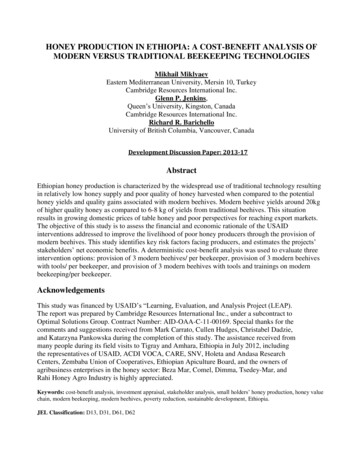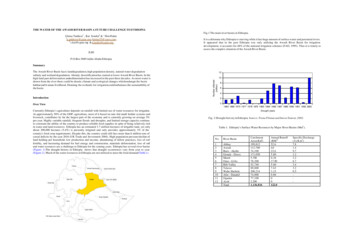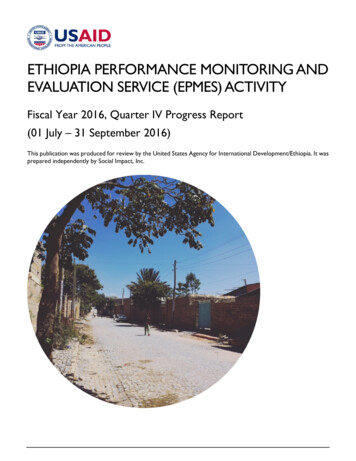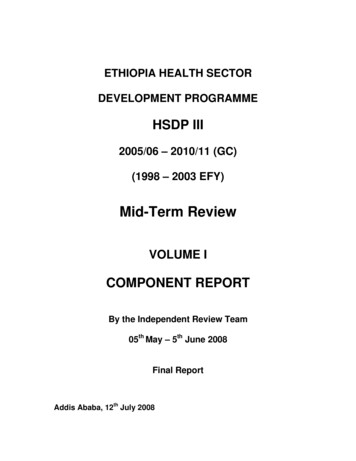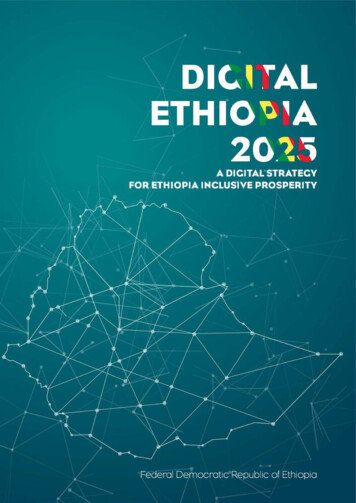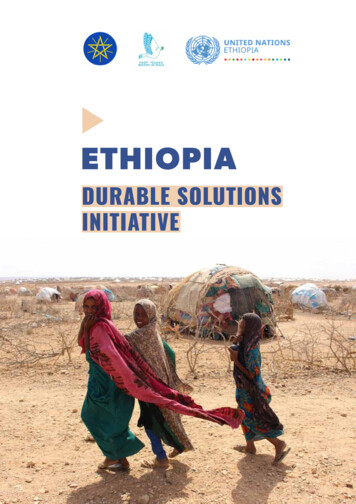
Transcription
ETHIOPIADURABLE SOLUTIONSINITIATIVE
ETHIOPIADURABLE SOLUTIONSINITIATIVEThe Ethiopia Durable Solutions Initiative (DSI)provides a principled operational framework andplatform to design and implement durable solutionsin support of internally displaced persons (IDPs) inEthiopia and host communities/communities atlocations of return, relocation or local integration.It aims at facilitating collective action andcooperation between the Ethiopian governmentauthorities at national, regional, and local levelsand the international community.It is based on and reflects relevant governmentalplans and strategies as well as internationalstandards including the 2010 United Nations (UN)Guiding Principles on Internal Displacement andthe 2010 Inter-Agency Standing Committee (IASC)Framework on Durable Solutions for InternallyDisplaced Persons.
WHAT ARE DURABLE SOLUTIONS TOINTERNAL DISPLACEMENT?A durable solution is achieved when internallydisplaced persons no longer have any specificassistance and protection needs that are linkedto their displacement and can enjoy their humanrights without discrimination on account of theirdisplacement. It can be done through sustainablereintegration at the place of origin (voluntaryreturn), local integration in areas where displacedpersons take refuge or in another part of thecountry based on their choice (relocation).IDPs have the right to make an informed andvoluntary choice on what durable solutions to pursueand to participate in the planning and managementof durable solutions. Active engagement of IDPsand the members of communities receiving them,including in restorative justice and reconciliationprocesses, is essential to make solutions sustainable.Finding durable solutions entails gradually reducingthe short and long-term needs of displacementaffected communities relating to physical, materialand legal security and enabling internally displacedpersons to rebuild their lives and to become selfreliant through sustainable economic and socialreintegration into society either at the locationof displacement, the place of origin or elsewhere12in the country. In short, they should be broughtto equal footing with the communities receivingthem in enjoying both their constitutional andfundamental human rights. Measures takenmust be gender and age-sensitive and addressthe specific needs of children and particularlyvulnerable persons such as persons with disabilitiesor traumatized individuals, unaccompanied childrenand female headed households. Effective remediesfor displacement related violations include accessto land for the purposes of shelter and livelihood.The Nairobi-based Regional Durable SolutionsSecretariat (ReDSS) has adapted the IASCFramework for Durable Solutions for InternallyDisplaced Persons to the regional context of theHorn of Africa and operationalized it, using 28outcome indicators1 organized around physical,material, and legal safety to measure the extent towhich durable solutions have been achieved in aparticular context. The Framework was designedas a tool that would contribute to increasing theavailability of data on displacement-affectedcommunities, thereby supporting the developmentof more solutions-oriented evidence-basedresponses in the region.2See List-of-ReDSS-framework-indicators.pdfSee ledge-management/solutions-framework/DURABLE SOLUTIONS INITIATIVE1
DURABLE SOLUTIONSINITIATIVEThe DSI has been developed by the Governmentof Ethiopia, the United Nations, international andnational non-governmental organizations (NGOs),and donors. Modeled after good practices in othercountries, the DSI in Ethiopia seeks to provide aprincipled operational framework to guide the workof all partners on durable solutions in the country.Its ultimate objective is to enable conditionsconducive for all internally displaced personsto achieve durable solutions in a principled way.Toward this end, the DSI will support politicalownership and leadership at the highest level,ensure community engagement, as well as linkingup the necessary humanitarian, development, andpeace actors to support durable solutions for IDPsat five levels:DSI SUPPORT LEVELS:POLICYMainstreaming the issues of displacement in key policy/strategydocuments, including in national development plans.LEGISLATIVESupporting the ratification of the Kampala Convention and thedevelopment of implementing legislation and/or policy.INSTITUTIONALStrengthening the coordination and operations of the federal andregional level working groups on durable solutions and seeking toenhance a whole-of-government approach to durable solutions.PLANNINGMainstreaming the issues of displacement in regional spatialplans, city-wide structure plans and neighborhood developmentplans.Implementing area-based, comprehensive, government-led andcommunity driven programmes in areas of voluntary return,relocation or local integration.OPERATIONALSupporting internally displaced households to find individualsolutions (e.g. through microfinancing or portability of socialprotection entitlements).Mainstreaming solutions into development programmes andhumanitarian action.2DURABLE SOLUTIONS INITIATIVE
POLICY LEVELLEGISLATIVE LEVELThe GoE is currently developing a 10 yearprospective plan, as well as its Growth and Transformation Plan III (2020/2021 – 2024/2025), and apeacebuilding strategy, which will guide the effortsand investments of the GoE and the developmentactors over the next five years. In parallel, theUnited Nations’ Country Team is developing itsnew UN Sustainable Development CooperationFramework (UNSDCF) and a multi-year resiliencestrategy to support the GoE. Efforts will be made bythe initiative to mainstream the agenda of durablesolutions for displacement affected communities inthese strategic documents.The federal government has initiated discussionwith the regional governments about the possibleratification of the African Union Convention for theProtection and Assistance of Internally DisplacedPersons in Africa (the 2009 Kampala Convention)with the support of the UN High Commissioner forRefugees (UNHCR). The Ministry of Foreign Affairshas transferred the ratification document to theCouncil of Ministers for endorsement.3In addition, the DSI will share Ethiopia’s experiencesworking towards durable solutions with the Highlevel Panel on Internal Displacement and the GP20platform, which is a multi-stakeholder initiativebringing together UN entities, NGOs, academia,UN Member States, the World Bank Group andthe International Red Cross and Red CrescentMovement to advance prevention, protection andsolutions for IDPs.Ratifying the Kampala Convention and adopting alaw and/or a policy to give it domestic effect, aswell as amending sectoral legislation or introducingnew domestic laws where needed, would besignificant milestones in Ethiopia’s efforts toprovide protection and assistance to IDPs andenable durable solutions for them. Support forlegislative reform is being provided by ProfessorChaloka Beyani, former Special Rapporteur onthe Human Rights of IDPs, UNHCR, and theInternational Committee of the Red Cross (ICRC).In addition to the official African Union translation of the Kampala Convention into the Somali language, UNHCR has supportedthe translation into the Amharic, Afan, Oromo and Tigriynia languages.3DURABLE SOLUTIONS INITIATIVE3
INSTITUTIONAL LEVELOPERATIONAL LEVELIn the Somali region of Ethiopia, a DurableSolutions Working Group was established in 2014.Efforts are now ongoing to replicate this goodpractice of coordination in other regional states(Afar, Gambella, Oromia and Southern Nations,Nationalities, and Peoples’ Region) affected byinternal displacement. Under the DSI, trainings andcross-regional learning are envisaged with differentline Ministries under the aegis of the federal levelDurable Solutions Working Group. The institutionalarchitecture is likely to evolve as the legislativereform agenda is implemented.Under the DSI, the aim is to support new jointprogrammes on internal displacement thatdemonstrate a “proof of concept” in supportingdurable solutions interventions in selected locations(see Toolbox). Initial projects will be implementedin the Somali and Oromia regions, with the viewto being scaled up across all displacement-affectedregions of the country.PLANNING LEVELThe current Ethiopian spatial planning systemincludes a National Urban Development SpatialPlan, Regional Urban Development Spatial Plansand, at local level, Structure Plans and Neighborhood Development Plans. Mainstreamingthe specific needs of displacement-affectedcommunities in the Ethiopian planning system,especially at regional, city and neighborhood level,is crucial to promote durable solutions for bothdisplaced and host communities.Reinforcing the system of human settlements willavoid making primary cities the first choice for IDPsand can make region and rural areas more resilientto climate-induce displacement. Considerations interms of natural resources availability, territorialclimate risk analysis and local clan-based landmanagement systems on regional planning canfacilitate local integration and the selection ofsuitable relocation sites, as well as the properintegration of IDP sites into the system of citiesand human settlements.4DURABLE SOLUTIONS INITIATIVESupport will be provided to the GoE to createflexibility within existing development financingin areas of voluntary return, local integration orrelocation across different sectoral areas to keepthe IDPs and former IDPs on the same footing withthe host community, in line with the DSI principles.
TOOLBOX FOR DURABLE SOLUTIONSArea-based interventions addressing the needs ofaffected communities in areas of return, relocationor local integration are best suited to achievedurable solutions. They should be complementedwith interventions targeting individuals andhouseholds which would allow them to findsolutions on their own (for instance for highlymobile traders, pastoralists and other businesspeople who will not necessarily move to or remainin areas of return or relocation). Support should bemade available that allows for continued mobility.As resources for solution-specific programmesand projects will necessarily remain insufficient,systematically integrating, where relevant andpossible, displacement affected communitiesinto relevant on-going or future developmentprogrammes and projects substantially strengthenactivities contributing to durable solutions.There is a need for strong data and evidencegathering as there are numerous gaps in what iscurrently available for IDPs and no comparisonwith host communities in terms of poverty andvulnerability aspects, which is key for targeting andmeasuring the impact of durable solutions. Suchdata collection will also be important for clarifyingwhat is meant by durable solution. The “end-point”of displacement is achieved when people havebeen able to overcome the specific vulnerabilitiesand protection needs that distinguish them fromother poor in the communities where they live, in asustainable manner.Protection is at the core of all efforts to promote orimplement durable solutions. In addition to effortsmade towards durable solutions, all stakeholdersshall ensure that urgent humanitarian needs ofIDPs are met, which is a pre-requisite for obtainingsolutions.The chart on the following pages provides anoverview of possible activities contributing to theachievement of durable solutions.DURABLE SOLUTIONS INITIATIVE5
1. AREA-BASED INTERVENTIONSCOMMON ACTIVITIES: Carry out intention surveys, taking intoaccount the related risks for IDPs who do notwant to return to an area. Provide accurate and adequate informationto allow each displaced person to makeinformed decision-making. Undertake a conflict risk profile on rootcauses and risk analysis with Do No Harmcomponents to reduce risks that interventionsfuel tension in the community. Develop community profiles to betterunderstand the situation, needs, and potentialsof displacement-affected communities. Bring displacement-affected communitiestogether to carry out gender/age/diversitybalanced community-based planning and buildsocial cohesion. Consider “quick win” conflict sensitiveinterventions that are effective and efficientsuch as using food/multi-purpose cashincentives to bring communities togetherto mitigate tensions due to limited naturalresources, as well as early investments inlivelihoods and in health. Support community-based rehabilitationor construction of permanent shelters byproviding building materials and technicalsupport, using preferably IDP manpower inthese efforts.6DURABLE SOLUTIONS INITIATIVE Support rehabilitation, expansion orconstruction of basic services and infrastructure,include incentivizing the use of these services(e.g. school meals to encourage attendance). Ensure financial access of IDPs/returnees tohealth and other social services (free ). Ensure the centrality of protection in allactions, including paying particular attention tothe risks of gender-based violence as well as theneeds of survivors. Support activities that strengthen socialcohesion, such as the creation of youth orwomen’s groups. Ensure that activities bring in the relevantline Bureaus as early as possible to ensure awhole-of-government approach and establishaccountability frameworks. Provide the displaced with assistance torestore personal identification and housing, landand property-related documentation. Establish strong monitoring and evaluationmechanisms to assess the sustainability of thereturns, relocations and local integration.
1.1TYPE OF INTERVENTION:Facilitating sustainable local integration in areas where IDPsare currently displacedLOCATION-SPECIFIC ACTIVITIES: Conduct spatial planning for expansion ofexisting urban or rural settlements, includingfor expansion of water, sanitation and hygiene(WASH), health, education and other socialservices. Provide land to IDPs for housing andlivelihoods ensuring adequate housing andland rights, including for female-headedhouseholds and minority groups and othermarginalized groups. Support informal settlement upgrading andregularization in urban areas where IDPs havesettled in informal areas. Re-enroll children in school to facilitate localintegration. Support host communities whose resourcesand resilience have been due to IDP presence. Support job creation in all ways possibleincluding through construction of incrementalhousing, key infrastructure investments andincentives that attract formal business andindustries. Support skills development to facilitate jobplacements for IDPs.DURABLE SOLUTIONS INITIATIVE7
1. AREA-BASED INTERVENTIONS1.28TYPE OF INTERVENTION:Facilitating safe, voluntaryand sustainable return1.3TYPE OF INTERVENTION:Facilitating sustainablerelocationLOCATION-SPECIFIC ACTIVITIES:LOCATION-SPECIFIC ACTIVITIES: Support go-and-see visits for IDP elders,women, men, children and youth in areas ofplanned return. Conduct training and awareness forgovernment officials and service providersfocused on conflict sensitive approaches toplanning and execution of public service andinfrastructure projects. Establish and run (temporary) medicalscreening centers. Prior to departure, returneesare assessed/advised on risks (i.e. pregnancy),existing health conditions are managed andcontinuation of treatments is ensured (i.e.chronic diseases such as tuberculosis). Develop community-driven programmesthat cover and link up communities on bothsides of regional borders. Strengthen/support the capacity of locallevel conflict resolution mechanisms andfacilitating/supporting reconciliation activities(e.g. “sports for peace” and cultural activities). Provide training and support for men,women, children and youth aimed at creatinga conducive environment for co-existence(e.g. creation of a youth or women groupsthat receive small resources to carry out jointactivities, including activities with a healthfocus). Where relevant, facilitate restitution ofland and other property and addressingother challenges related to housing, land andproperty (HLP) rights as well as facilitate accessto justice for crimes committed during conflict. Support go-and-see visits for IDP elders,women, men, children and youth in areas ofplanned relocation. Conduct spatial planning regarding housing,infrastructure and livelihood activities as wellas WASH, social, and education services tointegrate relocated communities. Provide land to relocated communities forhousing and livelihoods ensuring adequatehousing and land rights, including for femaleheaded and child-headed households. Support job creation through keyinfrastructure investments and incentives thatattract agro-processing and other forms of lightindustrial development and (re) establishmentof health and educational services. Implement appropriate mental healthservices (i.e. community healing dialogues)and if possible, link these with job creationprogrammes. Provide information on availability andaccessibility of services to the affectedpopulation.DURABLE SOLUTIONS INITIATIVE
2. FINDING INDIVIDUALIZED SOLUTIONS2.12.22.3TYPE OF INTERVENTION:Provision of start-up capitalKEY ACTIVITIES:ELEMENTS: Provide persons with necessary capital torestore livelihoods of their own choosing. Invest in skills and training to supportsustainable livelihoods. Grant seed money (cash grants) for small andmedium size enterprise development with aprinciple focus on vulnerable IDP groups suchas women and youth. Provide micro-credits for traders, farmersand other business people and support reformsto remove legal and institutional obstacles toaccess such financing (e.g. by provision of creditguarantee for micro-credit institutions). Support the creation of saving associationsfor male and female traders to facilitate accessto credits to establish small scale businesses.TYPE OF INTERVENTION:Social protection benefitsKEY ACTIVITY:ELEMENTS: Ensure that IDPs can be Productive SafetyNet Programmes (PSNP) clients in any locationto receive their entitlements. Support efforts to improve targeting based onvulnerability for long term displaced/returnees. Provide information, counselling andlegal assistance to IDPs living in protracteddisplacement on social protection programmes. Support obtention of digitalized identificationfor IDPs to access health services, obtaininsurance and financial exemption schemes.TYPE OF INTERVENTION:Access to adequate affordable housingKEY ACTIVITY:ELEMENTS: Ensure that IDPs have access to adequatehousing. Provide material support where needed forrural and urban housing, through incrementalhousing and self-build schemes. Facilitate micro-credit for incrementally builthousing in urban areas. Scale up housing provision in urban areasthrough public-private land developmentapproaches, based on land value capturemechanisms .DURABLE SOLUTIONS INITIATIVE9
3. MAINSTREAMING SOLUTIONS3.110TYPE OF INTERVENTION:Integration of displacement affected communities intodevelopment programmes and projects including on climatechange adaptable and mitigationKEY ACTIVITY:ELEMENTS: Systematic use of a solutions marker4for development programming whosemain purpose is not displacement-specific. Development actors include displacement relateddata into their analysis and assessments. Development actors include climate change/environmentally induced displacement related datainto their analysis and assessments. Development actors systematically ask themselves:Is the programme/project targeting areas andlocations, where IDPs and returnees live? If yes:How can internal displacement issues be included?5How development programs ‘does no harm’ to thedisplacement affected populations? Development plans of the GoE at all levels(regions, zone, woreda, kebele) and associatedbudget allocations, as well as sector Bureauxprogramming and budgeting systematically take intoaccount the specific needs of displacement-affectedcommunities. The IASC Durable Solutions Indicators areintegrated into project design, data collection andanalysis, and monitoring and evaluation (M&E).DURABLE SOLUTIONS INITIATIVE
3.2TYPE OF INTERVENTION:Integration of a solutions perspective into humanitarian actionKEY ACTIVITY:ELEMENTS: Systematic use of a resilience marker6 forhumanitarian programming in protracteddisplacement situations. Humanitarian actors ask themselves and askcommunities: Is the specific situation sufficiently safeand stable to help internally displaced household andcommunities making steps towards self-sufficiency?Is a sustainability/ handover component built intothe project? Is the project linked to government/community systems (e.g. in the areas of education,health, water), or to longer-term interventions?What are the associated resources both human andfinancially? Will the entitlements of target populationsto services/utilities be legally recognized?7“Solutions marker” refers to tools to assess whether a development programme or project whose main purpose is not displacementspecific is designed to include displacement affected communities rather than leaving them behind.5E.g. local government programmes/projects providing, e.g. (i) capacity building for LGs on displacement matters; (ii) supporting reformsthat ensure fiscal transfers and budget allocations to sub-national / local levels on the basis of the de-facto population rather than theregistered one.6“Resilience marker” refers to tools to assess whether a humanitarian programme or project would only have short-term life-savingeffects or whether it is designed to contribute to strengthening the resilience of IDPs at household and community levels and thuscontributes to their longer-term efforts to rebuild their lives.7OCHA, Somalia Humanitarian Response Plan 2019. Examples of humanitarian action with a resilience component would include theuse of school vouchers for public schools allowing authorities to hire additional teachers rather than short-term NGO-run schools; orthe provision of types of transitional shelter that can be transformed by occupants into durable housing at a later stage of recovery.4DURABLE SOLUTIONS INITIATIVE11
DURABLE SOLUTIONSPROGRAMMINGThe Durable Solutions Initiative will be governedby the following principles8:Rights- andNeeds-BasedGovernment-ledInterventions are guided by the needs, rights, legitimate interests,resources and capacities of displacement-affected communities.They respect the individual right of internally displaced persons tomake an informed and voluntary decision on what durable solutionto pursue and facilitate safe, unimpeded and timely access tosupport and information. Interventions aim at enabling internallydisplaced persons to fully enjoy all their economic, legal, sociocultural and civil-political rights without any discrimination forreasons related to their displacement. The respect of humanitarianprinciples should be also at the core of any durable solutions action,ensuring the Do No Harm principle with a protection centeredapproach. In order to be sustainable, pre-conditions to durablesolutions must be met, related to safety and security of the IDPsin the place of return/relocation/local integration, sufficient peaceand reconciliation progress, adequate justice and accountability.Interventions support the GoE in exercising its responsibilityfor facilitating durable solutions for displacement-affectedcommunities, leading and coordinating across sectors and all tiersof government based on national development plans and otherrelevant government frameworks. Interventions support national,federal and local government offices in planning, coordinating,delivering and monitoring services and programmes.These principles were developed by Regional Durable Solutions Secretariat (ReDSS) and the UN Somalia in 2019 and are alsoconsidered to be appropriate for the Ethiopian context.812DURABLE SOLUTIONS INITIATIVE
Participatory andCommunity-BasedInterventions enable displacement-affected communities, includingIDPs, returnees, and host communities/communities of return,relocation to actively participate in the selection, planning,implementation and monitoring of activities. Interventions helpcommunities define their own priorities and facilitate reconciliationand social cohesion among its members through inclusive processes.Area-basedInterventions target ‘displacement-affected communities’, includingIDPs, returnees, and those relocated or locally integrated, hostpopulations and communities of origin, in a defined area andrespond to the specific living conditions, risks and opportunities ofthe local context. Partners working in the same area aim at achievingcoherence and greater impact through joint analysis, planning andcoordination and through the creation of referral pathways.Recognition of unmet humanitarianneedsThe DSI recognizes the need for independent and impartialhumanitarian aid. The DSI does not seek to lead or integratehumanitarian assistance for IDPs but rather work in complementarity.Attention and funds to address both durable solutions andhumanitarian needs to be balanced. Any development assistanceshould be accompanied by the gradual reduction of humanitarianassistance, in a carefully managed and principled way.Collective andComprehensiveInterventions do not need to address all aspects of durablesolutions but should contribute to a long-term and comprehensiveapproach to internal displacement across sectors by humanitarian,development, human rights and peace/state-building actors.Partners work towards collective outcomes jointly pursued bygovernment and non-governmental actors, including civil society,affected individuals themselves, the private sector, research/academia and the international community.DURABLE SOLUTIONS INITIATIVE13
DURABLE SOLUTIONSPROGRAMMINGSensitive toSocial Inequalitiescaused by Sex, Age,Disabilities andMarginalizationInterventions give special attention to the specific concerns andperspectives of women through direct representation, children,youth, persons with disabilities, older persons and marginalizedgroups and take into consideration mechanisms of exclusionthat present barriers for accessing rights, services and equalopportunities in a non-discriminatory manner.Interventions facilitate locally-led solutions by the government,civil society/affected communities, the private sector andcommunities themselves. They strengthen the GoE’s rolethrough systematic capacity development to support institutionalprocesses and frameworks enabling durable solutions at all levels.SustainableInterventions prioritize full recognition of IDPs’ rights as citizensor habitual residents of their country, and as such seek to ensureaccess to existing government and community structures ratherthan establishing displacement-specific services structures.Interventions are conflict sensitive and contribute to sustainablepeacebuilding and development by respecting and going beyondDo No Harm. Interventions are based on long-term planning,multi-year time frames and budgets and can respond to changingdynamics through flexible and adaptive programming.14DURABLE SOLUTIONS INITIATIVE
WHO IS INVOLVED?The Durable Solutions Initiative is a new way ofworking and a joint endeavor by the Governmentof Ethiopia, the United Nations, international andnational NGOs and donors to provide a platformbringing together relevant actors engaged insupporting durable solutions.The DSI-Ethiopia will benefit from the supportof Professor Walter Kaelin, Special Advisor onDisplacement to the UN Resident Coordinator andHumanitarian Coordinator.The Ministry of Peace, together with the federallevel Durable Solutions Working Group members,chaired by NDRMC and co-chaired by theInternational Organization for Migration (IOM)and UN Resident Coordinator’s Office (RCO), isresponsible for supporting its implementation.For further information, please contact:A UN team on durable solutions has beenestablished under the auspices of the federallevel Durable Solutions Working Group to ensurea common UN response. The team is currentlychaired by the RCO and co-chaired by the Foodand Agriculture Organization (FAO). It is supportedby a Durable Solutions Secretariat.Mr. Megbaru AyalewDirector GeneralMinistry of Peaceayalewmegbaru@gmail.comMs. Hélène AtrafiDurable Solutions CoordinatorUN Resident Coordinator’s Officehelene.atrafi@one.un.orgDURABLE SOLUTIONS INITIATIVE15
ETHIOPIADURABLESOLUTIONSINITIATIVE
of Ethiopia, the United Nations, international and national non-governmental organizations (NGOs), and donors. Modeled after good practices in other countries, the DSI in Ethiopia seeks to provide a principled operational framework to guide the work of all partners on durable solutions in the country. Its ultimate objective is to enable conditions
